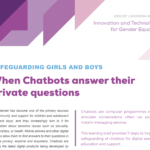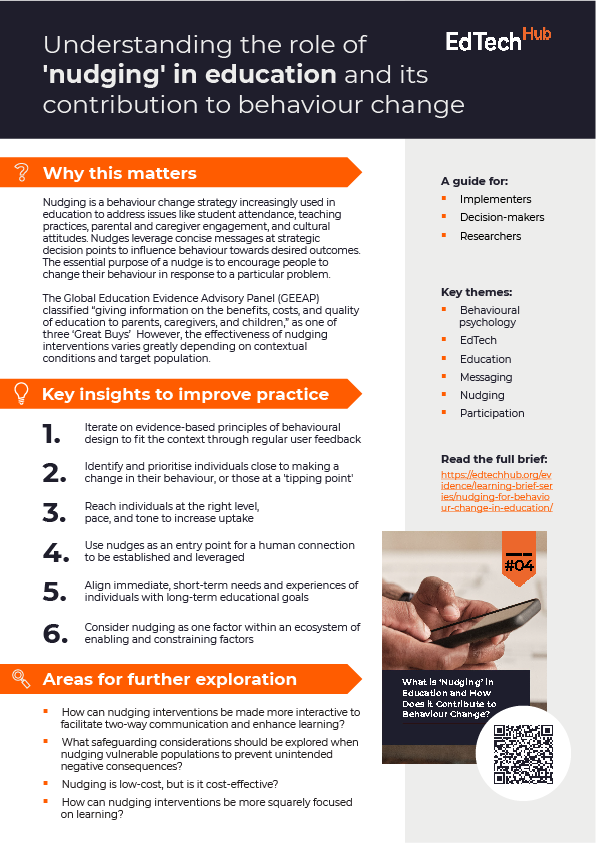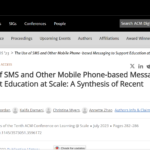What is ‘Nudging’ in Education and How Does it Contribute to Behaviour Change?
Part of the learning brief series
quick insights
full brief (pdf)
full brief (text)
A guide for
- Implementers
- Decision-makers
- Researchers
Why this matters
Nudging is a behaviour change strategy increasingly used in education to address challenges like student attendance, teaching practices, parental and caregiver engagement, and cultural attitudes. Nudges leverage concise messages at strategic decision points to influence behaviour towards desired outcomes. The essential purpose of a nudge is to encourage people to change their behaviour in response to a particular problem.
The Global Education Evidence Advisory Panel (GEEAP) classified “giving information on the benefits, costs, and quality of education to parents, caregivers, and children,” as one of three ‘Great Buys’ However, the effectiveness of nudging interventions varies greatly depending on contextual conditions and target population. Read on to learn more.
full brief (pdf)
full brief (text)
Key insights to improve practice
- Iterate on evidence-based principles of behavioural design to fit the context through regular user feedback
- Identify and prioritise individuals close to making a change in their behaviour, or those at a ‘tipping point’
- Reach individuals at the right level, pace, and tone to increase uptake
- Use nudges as an entry point for a human connection to be established and leveraged
- Align immediate, short-term needs and experiences of individuals with long-term educational goals
- Consider nudging as one factor within an ecosystem of enabling and constraining factors
Areas for further exploration
- How can nudging interventions be made more interactive to facilitate two-way communication and enhance learning?
- What safeguarding considerations should be explored when nudging vulnerable populations to prevent unintended negative consequences?
- Nudging is low-cost, but is it cost-effective?
- How can nudging interventions be more squarely focused on learning?
Useful tools and resources
A curated list of resources from EdTech experts to help continue your exploration of this topic.

Behaviour Change Key Principles for EdTech
a master framework by edtech hub

Safeguarding Boys and Girls: When Chatbots Answer Their Private Questions
The Use of SMS and Other Mobile Phone-based Messaging to Support Education at Scale: A Synthesis of Recent Evidence
a short paper on phone-based messaging

On Tipping Points and Nudges: Review of Cass Sunstein’s How Change Happens
Quick insights on one page
Dive into our one-page summary for quick, practical guidance. Click the image to view, print, or download.

full length brief
Twitter
LinkedIn
Email
Explore more from our learning brief series
Approaches to learning and engagement with EdTech
Communities of practice and participatory methods for EdTech
Cost-effectiveness and investments in EdTech
Education management systems (EMIS) for EdTech
Want to amplify the impact of this learning brief?
Share a quick card to help others access the latest evidence in EdTech. Your click can help share valuable insights.
Or, share the citation for this learning brief directly to our evidence library.
Your questions answered ?
Please contact EdTech Hub if you have any questions about our learning brief series, or if you would like to share your ideas for new learning brief topics which would help you in your work.
Citation
Koomar, S. (2024). What is “Nudging” and How Does it Change Behaviour in Education? [Learning Brief]. EdTech Hub. https://doi.org/10.53832/edtechhub.1011



